HUGE FLEET LEAVES JAPAN FOR PEARL HARBOR
Kurile Islands, Northern Japan · November 26, 1941
For several months the airmen of Japan’s First Naval Air Fleet had trained for an attack on the main base of the U.S. Pacific Fleet at Pearl Harbor on the Hawaiian island of Oahu. Squadrons of naval planes flew low over the city of Kagoshima on the southwestern tip of the Japanese island of Kyūshū—Kagoshima lay in the shadow of the Sakurajima volcano—making dummy runs against target vessels in the bay. Adm. Isoruku Yamamoto, since 1939 commander-in-chief of the Imperial Japanese Navy’s Combined Fleet, had chosen Kagoshima for its topographical similarity to Oahu.
Now on this date in 1941 all six of Japan’s first-line aircraft carriers—Akagi, Kaga, Shōkaku, Zuikaku, Hiryū, and Sōryū—sailed into history when they left the Kurile Islands in Northern Japan under the command of Vice Admiral Chūichi Nagumo. With over 420 embarked planes, the flattops constituted the then most powerful carrier task force ever assembled. (By October 1944 all six enemy flattops lay on the ocean bottom, courtesy of the U.S. Navy.) The Japanese Pearl Harbor Striking Force also included fast battleships, cruisers, destroyers, and submarines, with tankers to fuel the ships during their passage across the Pacific Ocean.
The Pearl Harbor Striking Force was positioning itself to carry out the surprise attack when, on December 1, it received the signal to bomb Pearl Harbor, which its carrier planes did on December 7, 1941, a date which, President Franklin D. Roosevelt told the U.S. Congress and the world the next day, “will live in infamy.” When Japanese Emperor Hirohito (posthumously referred to as Emperor Shōwa) asked Chief of Army General Staff Hajime Sugiyama about Japan’s prospects in a war against the U.S., he was assured that the war would be over in three months. Hirohito shot back that Sugiyama’s estimated timeframe for victory in the Sino-Japanese War, begin in 1937, never materialized.
In any event, the sneak attack on the U.S. Pacific Fleet and nearby airfields at Pearl Harbor was a stunning tactical victory for Japanese militarists, but it also spelled their doom—as well as Adolf Hitler’s and Benito Mussolini’s, whose countries declared war against the U.S. four days later out of respect for their Axis treaty partner. In all three cases, the leaders of Imperialist Japan, Nazi Germany, and Fascist Italy grossly underestimated the capacity of Americans—grim faced and determined—to avenge themselves on those who had brought an unprovoked war to their shores.
![]()
Japanese Attack on Pearl Harbor, December 7, 1941
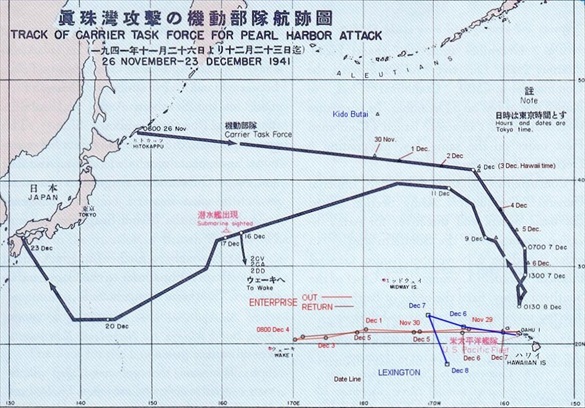 |
Above: Route of the Japanese Pearl Harbor Striking Force to and from Pearl Harbor (bold black). Routes of U.S. aircraft carriers Enterprise (red) and Lexington (blue) in early December are shown to the west of the Hawaiian Islands (right bottom corner).
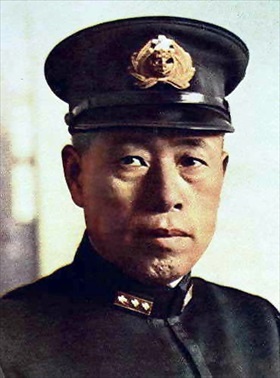 | 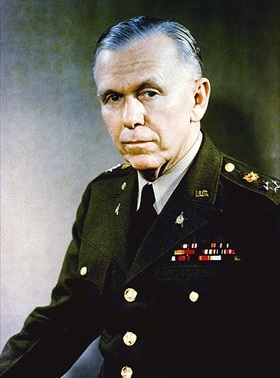 |
Left: In January 1941 Adm. Isoruku Yamamoto (1884–1943) outlined a surprise attack plan similar to that of the Royal Navy’s November 11, 1940, attack on the Italian fleet at Taranto, Italy. Yamamoto believed a preemptive strike on the U.S. naval fleet at Pearl Harbor could win the time his country needed to take over the rich mineral resources of British Malaya, the Dutch East Indies (especially its oilfields in what is today’s Indonesia), and the U.S. Philippines. All these foreign holdings now found themselves inside Japan’s so-called Greater East Asia Co-Prosperity Sphere, unilaterally launched on June 29, 1940. Faced with a military “fait accompli,” the U.S., Yamamoto hoped, might accept a truce, adding, “the outcome must be decided on the first day.” In April 1941 he ordered plans drawn up for “Operation Z,” the attack on Pearl Harbor, confiding to a staff officer, “If we fail, we’d better give up the war.”
![]()
Right: George Marshall (1880–1959), Chief of Staff of the Army since September 1939, had visited Oahu in 1940 and considered Hawaii “the strongest fortress in the world.” In May 1941 he reported to President Roosevelt that “enemy carriers and escorts and transports will begin to come under air attack at a distance of 750 miles” should it come to that. He concluded that “a major attack against Oahu is considered impractical.”
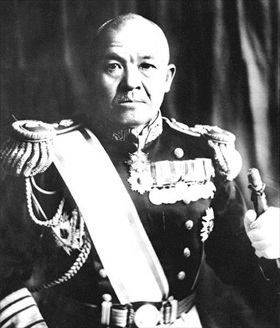 | 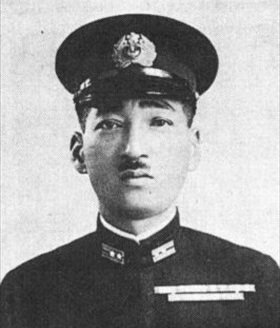 |
Left: On April 10, 1941, Vice Admiral Chūichi Nagumo (1887–1944) was appointed Commander-in-Chief of the First Air Fleet, the Japanese Navy’s main aircraft carrier force, largely owing to his seniority. (He had graduated from the Imperial Japanese Naval Academy in 1908.) A strong advocate of combining sea and air power but a cautious man, Nagumo was opposed to Adm. Yamamoto’s plan to attack the U.S. Navy at Pearl Harbor. His greatest mistake on that fateful Sunday morning in December was to call off a third strike by his carrier planes, which might have destroyed not only the fuel oil storage and repair facilities, thereby rendering the most important U.S. naval base in the Pacific useless, but the submarine base and intelligence station. Nagumo’s missing these targets of opportunities contributed to his nation’s eventual defeat.
![]()
Right: Mitsuo Fuchida (1902–1976) was a Japanese captain in the Imperial Japanese Navy Air Service and a bomber aviator in the Japanese Navy before and during World War II. He is perhaps best known for leading the first air wave attacks on Pearl Harbor on December 7, 1941. Working under Vice Admiral Nagumo, Fuchida was responsible for coordinating the entire aerial attack. He missed being killed or wounded by one day when the atomic mushroom cloud destroyed Hiroshima on August 6, 1945. In 1949 he converted to Christianity, became a missionary, moved to the U.S., and met many of his former enemies, including ex-President Harry S. Truman, President Dwight D. Eisenhower, and Admirals Chester W. Nimitz, William Halsey, and Raymond Spruance.
Japanese and U.S. Naval Preparations on Eve of December 7, 1941
![]()

 History buffs, there is good news! The Daily Chronicles of World War II is now available as an ebook for $4.99 on Amazon.com. Containing a year’s worth of dated entries from this website, the ebook brings the story of this tumultuous era to life in a compelling, authoritative, and succinct manner. Featuring inventive navigation aids, the ebook enables readers to instantly move forward or backward by month and date to different dated entries. Simple and elegant! Click
History buffs, there is good news! The Daily Chronicles of World War II is now available as an ebook for $4.99 on Amazon.com. Containing a year’s worth of dated entries from this website, the ebook brings the story of this tumultuous era to life in a compelling, authoritative, and succinct manner. Featuring inventive navigation aids, the ebook enables readers to instantly move forward or backward by month and date to different dated entries. Simple and elegant! Click 











